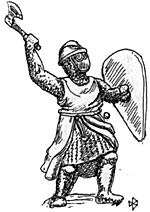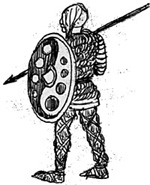 Introduction
Introduction
The following rules system is heavily influenced by both the DBA and Shieldbearer rule sets. The basic philosophy links morale and orders. Units with good morale will follow orders and/or act aggressively towards the enemy. Units that take enough casualties will start to withdraw from the field of battle.
Orders
Write orders for each unit at the beginning of the game - Skirmish/Attack; Defend; Withdraw. Think carefully about what you want to achieve on the tabletop. These orders may NOT be changed during the game.
| Sample order sheet | |||
|---|---|---|---|
| Warband 1 | 1 2 3 4 | 5 6 7 8 | 9 10 11 12 |
| Withdraw | Attack | Attack | |
| Warband 2 | 1 2 3 4 | 5 6 7 8 | 9 10 - - |
| Withdraw | Defend | Attack | |
| Archers 1 | 1 2 3 4 | 5 6 7 8 | 9 - - |
| Withdraw | Skirmish | Skirmish | |
Morale
Orders and morale are linked. All units start with 6 morale points plus the score on a six sided die (all dice used in these rules are the normal six sided variety). 1-4 must be withdraw; 5+ are at the discretion of the general. All personal retinue (i.e. generalís bodyguard) automatically have 12 points.
Command and Control
Throw one die per side. The lowest score stands fast. Highest score throws again - this score being the number of points available to the general. Any unit more than 900 mm away from the general costs another point to move.
Movement per 1 pip
All infantry 150 mm
Mounted knights 300 mm
Chariots 300 mm
Elephant 300 mm
Other horse 450 mm
Camels 450 mm
Combat
Distant shooting ranges
All bows, except longbows 150 mm
Hand held powder weapons 150 mm
Longbow 300 mm
Bolt throwing engine 300 mm
All combat, distant shooting and melee are resolved on the following table.
Only the defender dices.
| Dice | (7) | 6 | 5 | 4 | 3 | 2 | 1 | (0) |
| Points | 0 | 0 | 1 | 1 | 2 | 2 | 3 | 3 |
Modifiers
- Each flank overlapped 1 column right
Attacked in rear 2 column right
Attacked in flank 1 column right
Friendly troops breaking within 300 mm 2 columns right
First hand to hand combat 1 column right
No armour or shield 1 column right
Opposing berserkers 2 columns right
Opposing elephants 2 columns right
Opposing camels 1 column right
Infantry v. horse 1 column right
Defending from cover 1 column left
Uphill of enemy 1 column left
General with formation 2 columns left
Throw a die and modify as per the table. Remove that number of morale points from the losing side. The losing side pulls back 150 mm. As the points diminish so the orders for the unit will change. (See the sample order sheet).
 Pursuit
Pursuit
A unit with Skirmish/Attack orders may pursue a withdrawing enemy. Roll less than or equal to current morale score on one die. Other orders will not allow pursuit.
Recovery
Once a unit is withdrawing and out of contact with the enemy there is a chance to restore morale points. Each turn that the unit is out of contact/combat throw a die. (N.B. If you are being shot at you are not out of contact). Roll a die and score equal to or less than current morale to add one more morale point up to a maximum of half the original score.
Berserk
Throw a die for each warband. On a score of 6 the warband is berserk. Automatic attack orders - no withdrawal. Once defeating an enemy unit it will go on and attack the next nearest enemy unit until the warband or the enemy are destroyed. Berserk units move towards the enemy regardless of who wins the die roll for movement. (e.g. Roman Legions versus Gallic Warbands. One of the Warbands is berserk; Roman is the highest score and will dice again for movement. The berserk Warband will also move, but no other Gallic forces.
Well, there it is. I hope that you try this set up and enjoy it. If anyone has any comments or queries send them in to the Forum.
Back to Table of Contents -- Lone Warrior #140
Back to Lone Warrior List of Issues
Back to MagWeb Magazine List
© Copyright 2002 by Solo Wargamers Association.
This article appears in MagWeb (Magazine Web) on the Internet World Wide Web.
Other military history articles and gaming articles are available at http://www.magweb.com
